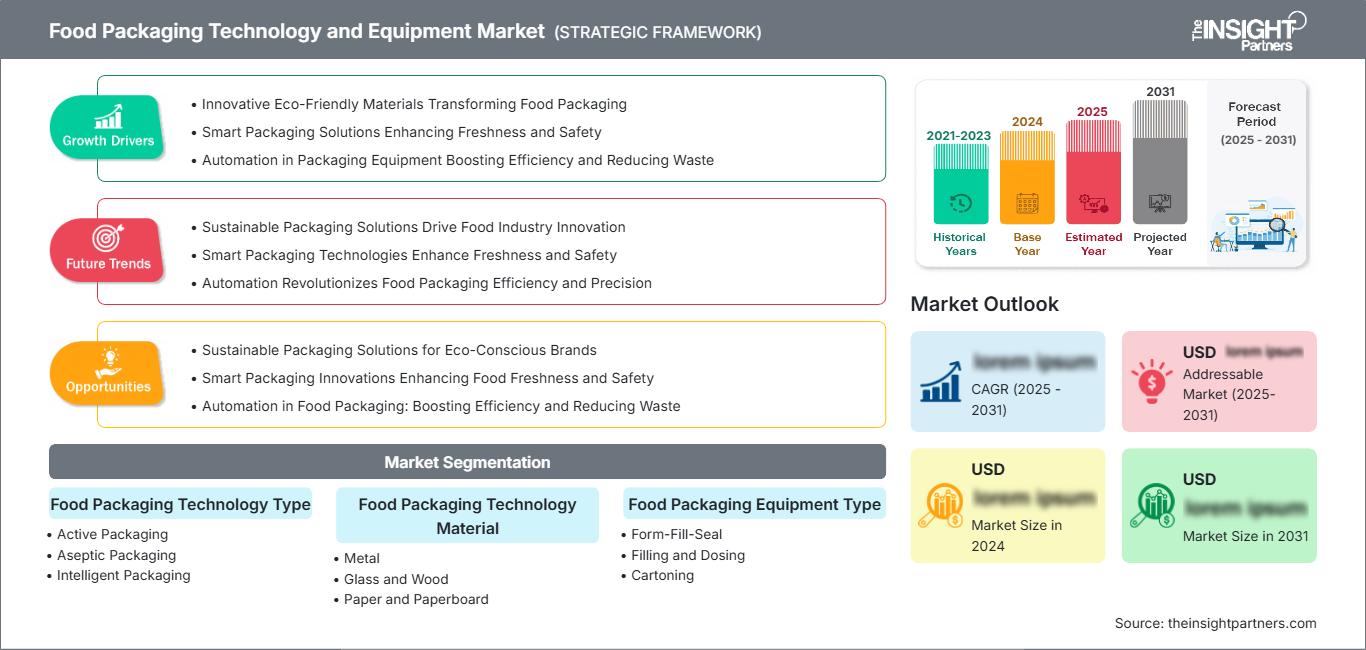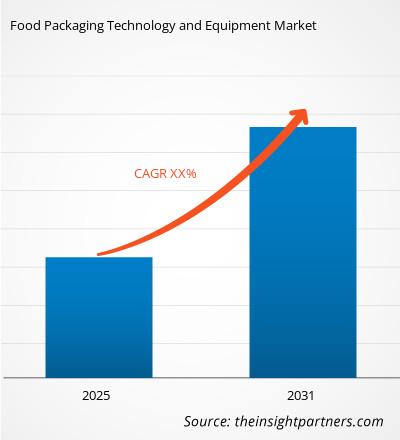Si prevede che il mercato delle tecnologie e delle attrezzature per il confezionamento alimentare registrerà un CAGR del XX% dal 2025 al 2031, con una dimensione del mercato in espansione da XX milioni di dollari USA nel 2024 a XX milioni di dollari USA entro il 2031.
Il rapporto è suddiviso in base al tipo di tecnologia per il confezionamento alimentare (confezionamento attivo, confezionamento asettico, confezionamento intelligente, confezionamento biodegradabile, altri tipi) e analizza ulteriormente il mercato in base al materiale della tecnologia per il confezionamento alimentare (metallo, vetro e legno, carta e cartone, plastica, altri materiali). Esamina inoltre il mercato per tipologia di apparecchiature per l'imballaggio alimentare (Form-Fill-Seal, Riempimento e Dosaggio, Incartonamento, Incartonamento, Avvolgimento e Legatura, Etichettatura e Codifica, Macchine per Ispezione, Rilevamento e Controllo del Peso, Altre Apparecchiature) e per applicazione industriale delle tecnologie e delle apparecchiature per l'imballaggio alimentare (Cibi pronti, Pollame, Pesce e Carne, Prodotti da Forno, Prodotti Dolciari, Latticini e Prodotti Caseari, Frutta e Verdura). Per ciascuno di questi segmenti chiave viene fornita una ripartizione completa a livello globale, regionale e nazionale. Il rapporto include le dimensioni del mercato e le previsioni per tutti i segmenti, presentando i valori in USD. Fornisce inoltre statistiche chiave sullo stato attuale del mercato dei principali attori, insieme ad approfondimenti sulle tendenze di mercato prevalenti e sulle opportunità emergenti.
Scopo del rapporto
Il rapporto Food Packaging Technology and Equipment Market di The Insight Partners mira a descrivere il panorama attuale e la crescita futura, i principali fattori trainanti, le sfide e le opportunità. Ciò fornirà spunti a vari stakeholder aziendali, come:
- Fornitori/produttori di tecnologia: per comprendere le dinamiche di mercato in evoluzione e conoscere le potenziali opportunità di crescita, consentendo loro di prendere decisioni strategiche informate.
- Investitori: per condurre un'analisi completa delle tendenze in merito al tasso di crescita del mercato, alle proiezioni finanziarie del mercato e alle opportunità esistenti lungo la catena del valore.
- Organismi di regolamentazione: per regolamentare le politiche e le attività di controllo nel mercato con l'obiettivo di ridurre al minimo gli abusi, preservare la fiducia degli investitori e sostenere l'integrità e la stabilità del mercato.
Segmentazione del mercato delle tecnologie e delle attrezzature per il confezionamento alimentare Tipo di tecnologia per il confezionamento alimentare
- Imballaggio attivo
- Imballaggio asettico
- Imballaggio intelligente
- Imballaggio biodegradabile
- Altri tipi
Materiale della tecnologia per il confezionamento alimentare
- Metallo
- Vetro e legno
- Carta e cartone
- Plastica
- Altri materiali
Tipo di attrezzatura per il confezionamento alimentare
- Formatura, riempimento e sigillatura
- Riempimento e dosaggio
- Incartonamento
- Imballaggio in scatole
- Avvolgimento e raggruppamento
- Etichettatura e codifica
- Macchine di ispezione, rilevamento e controllo del peso
- Altre attrezzature
Applicazione della tecnologia e delle attrezzature per il confezionamento alimentare
- Cibo pronto
- Pollame, pesce e prodotti a base di carne
- Prodotti da forno
- Prodotti dolciari
- Latticini e prodotti caseari
- Frutta e verdura
Potrai personalizzare gratuitamente qualsiasi rapporto, comprese parti di questo rapporto, o analisi a livello di paese, pacchetto dati Excel, oltre a usufruire di grandi offerte e sconti per start-up e università
Mercato delle tecnologie e delle attrezzature per l'imballaggio alimentare: Approfondimenti strategici

-
Ottieni le principali tendenze chiave del mercato di questo rapporto.Questo campione GRATUITO includerà l'analisi dei dati, che vanno dalle tendenze di mercato alle stime e alle previsioni.
Fattori di crescita del mercato delle tecnologie e delle attrezzature per il confezionamento alimentare
- Materiali innovativi ecocompatibili trasformano il confezionamento alimentare
- Soluzioni di confezionamento intelligenti che migliorano la freschezza e la sicurezza
- Automazione nelle attrezzature per il confezionamento: aumento dell'efficienza e riduzione degli sprechi
Tendenze future del mercato delle tecnologie e delle attrezzature per il confezionamento alimentare
- Le soluzioni di confezionamento sostenibili guidano l'innovazione nel settore alimentare
- Le tecnologie di confezionamento intelligenti migliorano la freschezza e la sicurezza
- L'automazione rivoluziona l'efficienza e la precisione del confezionamento alimentare
Opportunità di mercato delle tecnologie e delle attrezzature per il confezionamento alimentare
- Soluzioni di confezionamento sostenibili per marchi eco-consapevoli
- Innovazioni nel confezionamento intelligente che migliorano la freschezza e la sicurezza degli alimenti
- Automazione nel confezionamento alimentare: aumento dell'efficienza e riduzione degli sprechi Rifiuti
Approfondimenti regionali sul mercato delle tecnologie e delle attrezzature per il confezionamento alimentare
Le tendenze regionali e i fattori che influenzano il mercato delle tecnologie e delle attrezzature per il confezionamento alimentare durante il periodo di previsione sono stati ampiamente spiegati dagli analisti di The Insight Partners. Questa sezione illustra anche i segmenti e la geografia del mercato delle tecnologie e delle attrezzature per il confezionamento alimentare in Nord America, Europa, Asia-Pacifico, Medio Oriente e Africa, America meridionale e centrale.
Ambito del rapporto di mercato sulla tecnologia e le attrezzature per l'imballaggio alimentare
| Attributo del rapporto | Dettagli |
|---|---|
| Dimensioni del mercato in 2024 | US$ XX Million |
| Dimensioni del mercato per 2031 | US$ XX Million |
| CAGR globale (2025 - 2031) | XX% |
| Dati storici | 2021-2023 |
| Periodo di previsione | 2025-2031 |
| Segmenti coperti |
By Tipologia di tecnologia di confezionamento alimentare
|
| Regioni e paesi coperti |
Nord America
|
| Leader di mercato e profili aziendali chiave |
|
Densità degli operatori del mercato delle tecnologie e delle attrezzature per l'imballaggio alimentare: comprendere il suo impatto sulle dinamiche aziendali
Il mercato delle tecnologie e delle attrezzature per il confezionamento alimentare è in rapida crescita, trainato dalla crescente domanda degli utenti finali, dovuta a fattori quali l'evoluzione delle preferenze dei consumatori, i progressi tecnologici e una maggiore consapevolezza dei benefici dei prodotti. Con l'aumento della domanda, le aziende stanno ampliando la propria offerta, innovando per soddisfare le esigenze dei consumatori e sfruttando le tendenze emergenti, alimentando ulteriormente la crescita del mercato.

- Ottieni il Mercato delle tecnologie e delle attrezzature per l'imballaggio alimentare Panoramica dei principali attori chiave
Punti di forza
- Copertura completa: il rapporto analizza in modo esaustivo prodotti, servizi, tipologie e utenti finali del mercato delle tecnologie e delle attrezzature per il confezionamento alimentare, offrendo una panoramica olistica.
- Analisi degli esperti: il rapporto è redatto sulla base della conoscenza approfondita di esperti e analisti del settore.
- Informazioni aggiornate: il rapporto garantisce la pertinenza aziendale grazie alla copertura di informazioni e tendenze dei dati recenti.
- Opzioni di personalizzazione: questo rapporto può essere personalizzato per soddisfare le esigenze specifiche del cliente e adattarsi in modo appropriato alle strategie aziendali.
Il rapporto di ricerca sul mercato delle tecnologie e delle attrezzature per il confezionamento alimentare può quindi contribuire a guidare il percorso di decodificazione e comprensione dello scenario del settore e delle prospettive di crescita. Sebbene possano esserci alcune valide preoccupazioni, i vantaggi complessivi di questo rapporto tendono a superare gli svantaggi.
- Analisi storica (2 anni), anno base, previsione (7 anni) con CAGR
- Analisi PEST e SWOT
- Valore/volume delle dimensioni del mercato - Globale, Regionale, Nazionale
- Industria e panorama competitivo
- Set di dati Excel
Report recenti
Rapporti correlati
Testimonianze
Motivo dell'acquisto
- Processo decisionale informato
- Comprensione delle dinamiche di mercato
- Analisi competitiva
- Analisi dei clienti
- Previsioni di mercato
- Mitigazione del rischio
- Pianificazione strategica
- Giustificazione degli investimenti
- Identificazione dei mercati emergenti
- Miglioramento delle strategie di marketing
- Aumento dell'efficienza operativa
- Allineamento alle tendenze normative






















 Ottieni un campione gratuito per - Mercato delle tecnologie e delle attrezzature per l'imballaggio alimentare
Ottieni un campione gratuito per - Mercato delle tecnologie e delle attrezzature per l'imballaggio alimentare